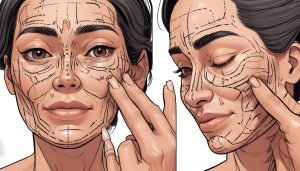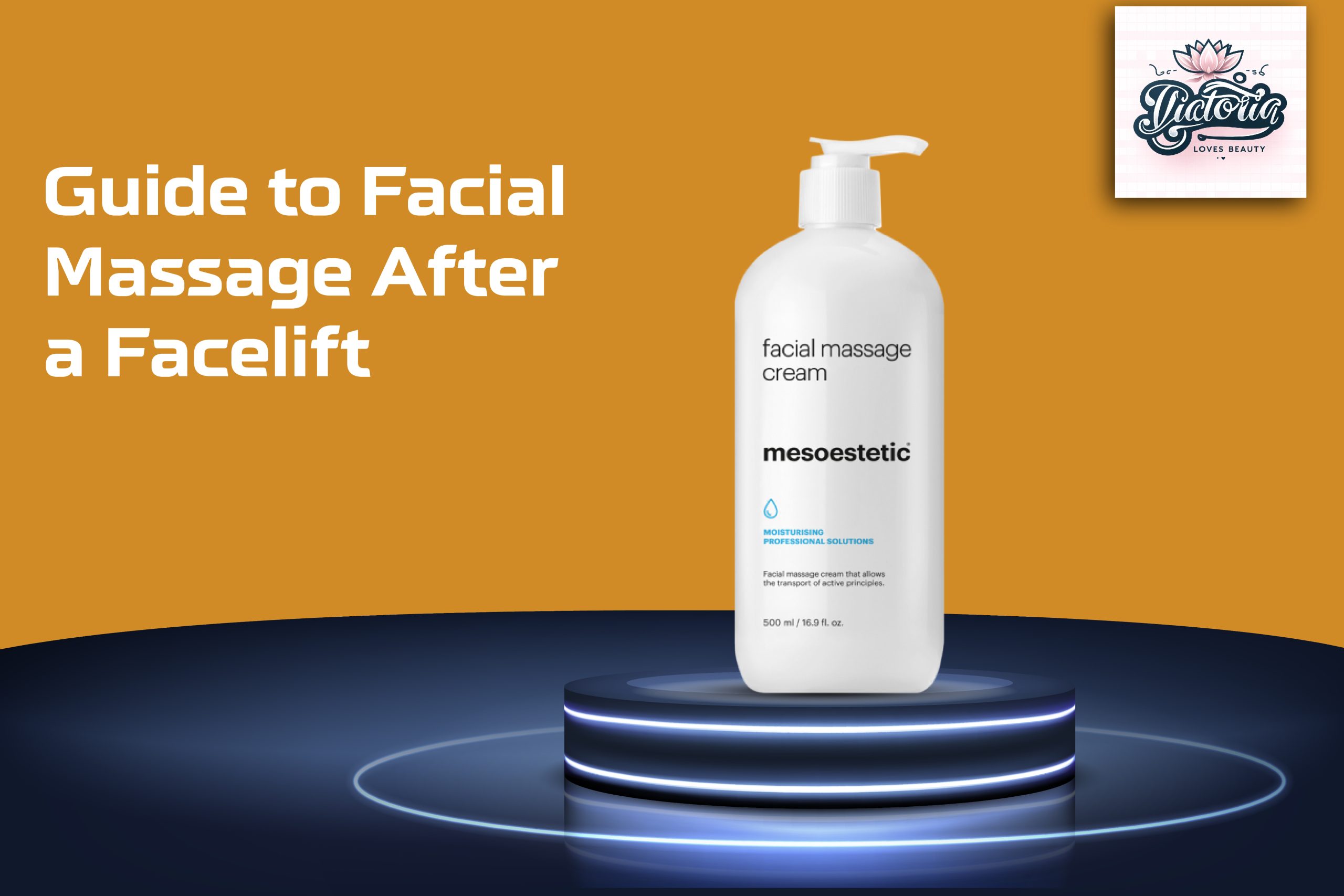After a facelift, your journey towards healing and rejuvenation isn’t over. An essential part of the post-surgical process is facial massage. It’s not just about indulgence; it’s crucial to ensuring a smooth, swift, and comfortable recovery. This guide combines expert insights to explain how you can effectively and safely perform facial massages after your facelift. These massages promote better blood circulation, reduce swelling, and help your facial muscles regain their natural tone. You can gently and strategically massage the treated areas to alleviate tension and expedite the healing process.
Understanding Post-Lift Massaging
Understanding post-facelift massage is crucial for anyone thinking about having facial rejuvenation surgery or recuperating from it. The therapeutic goal of post-facelift massage is to improve overall outcomes, minimize edema, and speed up the healing process. It includes mild methods customized to meet each patient’s needs, such as Swedish massage, lymphatic drainage, and scar tissue manipulation. These massages help to reduce discomfort, speed up the healing of scars, and improve the look of the skin by encouraging healthy blood circulation and tissue flexibility. To ensure that post-facelift massages are conducted correctly and safely and to maximize the advantages of your facelift treatment, you must get advice from a skilled practitioner or adhere to your surgeon’s instructions.
The Benefits of Facial Massage Post-Facelift
- Enhance Healing: Increasing blood circulation in the massaged regions is one of the main advantages of face massages. Enhancing blood circulation provides vital nutrients to the skin, hastening the healing process. Moreover, improved circulation ensures a healthy recovery by preventing the accumulation of pollutants.
- Minimize Swelling and Bruising: Swelling and bruising are common side effects after facelift surgery. Massages on the face are essential for lymphatic drainage because they transfer surplus fluids from the tissues of the face to the lymph nodes. This facilitates a faster and more pleasant recovery by lowering swelling and the visibility of bruises.
- Reduce Pain: Warmth applied to the treated regions through deftly executed massages can reduce pain receptor sensitivity. This all-natural pain reliever can significantly improve your comfort level throughout healing.
- Reduce Scarring: Massaging the face helps reduce the amount of scar tissue that forms. Massages can help break down tissue accumulation by gently adjusting the skin and underlying tissues, making scars less noticeable and the skin surrounding them softer and more malleable. Your facelift operation may have a more attractive appearance due to this.
When to Begin Facial Massages
The timing of facial massages following a facelift is crucial to the post-operative care regimen. Safety and efficacy must be guaranteed when starting face massages early in the healing process. When to begin receiving face massages is usually determined by your surgeon’s advice and depends on how your surgical incisions and treated regions are healing specifically.
In general, here’s a guideline for when to consider starting facial massages:
- Wound Closure: It is essential to wait until all surgical wounds and incisions have completely closed. This typically takes at least several days to a few weeks, depending on the extent of the procedure and individual healing rates. Premature massages on open wounds can risk infection and hinder the healing process.
- Surgeon’s Approval: Always seek approval from your surgeon or a qualified healthcare professional before starting any post-facelift massages. They will assess your recovery progress and provide personalized guidance on when it is safe to begin.
- Bruising and Swelling: It’s advisable to wait until significant bruising and swelling have subsided. Massaging swollen areas can potentially exacerbate these symptoms. Your surgeon can advise you on the appropriate timing based on your recovery.
- Comfort and Sensation: You should have regained enough sensation in the treated areas to avoid unintentional harm during the massage. Numbness is common after a facelift, but you should be able to feel enough to perform gentle massages without causing discomfort or injury.
- Follow-up appointments: Attend follow-up appointments with your surgeon as scheduled. They will assess your progress and determine when you are ready for facial massages as part of your recovery plan.
How to Properly Massage Your Face Post-Facelift

Wait for Healing: It’s essential to wait until the surgical incisions have completely healed and begun to heal before starting any face massages. Usually, your surgeon will advise you on the appropriate time to begin.
Select the Appropriate Method:
- Swedish Massage: Employ gentle, upward strokes to gradually restore sensation in treated areas, ensuring cleanliness to prevent infection.
- Lymphatic Massage: Utilize gentle, rhythmic strokes directed toward lymph nodes near the ears and neck to enhance blood flow and reduce swelling, aiding fluid elimination.
- Scar Massage: Focus on softening scar tissue using small, circular motions with fingertips, enhancing skin elasticity and reducing the long-term visibility of scars.
Use Appropriate Products: Always use an appropriate oil or lotion as a lubricant and moisturizer when giving yourself a face massage. These items facilitate massages by lowering friction without adding needless strain to your skin. To determine which product is best for your skin type, speak with your surgeon or a skincare expert.
Be Gentle: Being gentle is crucial during facial massages after a facelift. Since the treated regions will still be sensitive during the early stages of recovery, avoid applying deep or hard pressure. Make sure you move carefully and gently to avoid causing harm or discomfort.
Types of Massages Explained
- Swedish Massage: Following a facelift, Swedish massage is the best option for restoring feeling in the treated regions. It calls for the use of soft, upward strokes. The main objective is gradually restoring skin sensitivity while taking extra care and delicacy.
- Lymphatic massage: The primary goals of lymphatic massage are lymph node activation and edema reduction. The lymph nodes, frequently found close to the ears and neck, are the target of these massages’ soft, rhythmic strokes. By doing this, lymphatic massages improve blood flow and make it easier for extra fluid to be effectively removed from the treated regions.
- Scar Massage: Three weeks after surgery is usually when scar massage starts. Its main goal is to lessen the thickness and soften the scar tissue. People who are massaging scars use their fingertips to move in gentle circular patterns over the affected regions. This method helps to increase the skin’s suppleness and may eventually help scars become less apparent. It is a crucial step in healing following a facelift for scar control.
Areas to Focus On

When considering post-facelift facial massages, understanding the specific areas to focus on is crucial for achieving the best results and ensuring a comfortable recovery. Here are key areas to pay special attention to:
- Incision Sites: Begin by gently massaging around the incision sites. These areas often require extra care, as they may initially feel tight or slightly raised. Massaging can help promote scar softening and improve the overall appearance of scars.
- Swollen Areas: If you have areas of swelling or puffiness, such as around the cheeks or jawline, focus on these regions. Lymphatic massage techniques, with gentle strokes directed toward the lymph nodes, can help reduce swelling and expedite the drainage of excess fluids.
- Scar Tissue: Scar massage is essential to minimize the visibility of scars. Concentrate on the scar tissue, using gentle circular motions with your fingertips. This can enhance skin elasticity and make scars less noticeable over time.
- Facial Muscles: Gently work on the facial muscles to help them regain their natural tone and flexibility. Swedish massage techniques with light, upward strokes can be effective, especially in areas that may have felt tight or numb after the surgery.
- Under the Eyes: Be delicate when massaging the delicate skin under the eyes. Use light pressure and gentle tapping or patting to reduce puffiness and promote blood circulation.
- Neck and Jawline: Include the neck and jawline in your massage routine, as these areas are often treated during a facelift. Gentle strokes in an upward direction help maintain a harmonious transition between the facial and neck areas.
- Temple and Forehead: Pay attention to the temple and forehead regions, as they can also benefit from improved circulation and relaxation. Light, soothing strokes can alleviate tension and discomfort.
- Overall Face: While focusing on specific areas is essential, remember to provide a comprehensive massage to the entire face. This ensures a balanced approach and promotes a harmonious result.
Frequency and Duration
A good recovery from a facelift depends on how often and how long facial massages are given. The precise regimen may change based on the surgeon’s advice and personal circumstances. It’s usual to begin with quick workouts in the beginning, lasting five to ten minutes and carried out many times a day. You can progressively increase the length and frequency of your massages as your recovery continues. Many people discover that getting regular massages gets more accessible and more helpful as their recuperation progresses; this is common for weeks to months after surgery. But it’s essential to balance and refrain from going overboard; too solid or prolonged massages may impede healing. Always speak with your surgeon for a customized strategy that fits your unique needs.
Additional Tips for Facelift Recovery
- Follow Aftercare Instructions: For a speedy recovery, heed the advice given by your surgeon. This covers appropriate wound care, medication administration, and any particular recommendations about your circumstance. For best effects, make sure you follow these directions every time.
- Steer Clear of Sunlight and Bad Habits: Stay out of direct sunlight to preserve your skin, especially in the first few weeks following surgery. Skin pigmentation problems and scarring can result from sun exposure. It would help if you also avoided terrible habits like smoking and binge drinking because they might impede your recovery and hurt your outcome.
- Rest and Recovery: At the beginning of your healing process, prioritize your body’s needs. Steer clear of demanding activities and allow your body the time it requires to recover. Sufficient rest and sleep contribute to a smoother and faster recovery process.
- Eat Nutritious Foods and Stay Hydrated: Eating a well-balanced diet high in vitamins and minerals and staying hydrated will boost your general healing process and help tissue repair. To aid healing, eat meals with protein and antioxidants and drink lots of water.
- Control Pain and Discomfort: Follow your surgeon’s instructions and take the recommended painkillers as soon as possible. Proper pain management may keep you comfortable during the healing process and lessen the strain on your body.
- Keep All Scheduled Follow-Up Visits: Ensure you attend your surgeon’s follow-up visits. During these appointments, your surgeon can monitor your development, correct any issues, and modify your recovery plan.
Ultrasonic Treatments for Thick Scarring
It is best to discuss ultrasonic treatments with your surgeon in cases where there is extensive scarring or fluid collections under the skin after a facelift. Ultrasonic therapies, such as ultrasonic liposuction or ultrasound therapy, might be regarded as cutting-edge methods to deal with these problems. They efficiently tear down scar tissue and aid in resolving fluid buildup by penetrating deep layers of tissue with high-frequency sound waves. Your surgeon could suggest these procedures as an extra precaution to enhance the comfort and look of the regions treated during your facelift recuperation.
Before and After Care
- Stay Hydrated: Adequate hydration is essential. Drink plenty of fluids before and after the massage to support healing, maintain skin health, and help your body flush out toxins.
- Elevate Your Head While Sleeping: To prevent excessive blood flow to the face and minimize swelling, try sleeping with your head elevated at an angle using extra pillows. This can help ensure a more comfortable and restful night’s sleep during the initial stages of your recovery.
- Keep Moving: As recommended by your surgeon, engaging in gentle physical activity can promote healthy blood circulation and aid in recovery. Short, leisurely walks or light exercises can prevent stiffness and encourage the body’s natural healing mechanisms. However, be cautious to avoid overexerting yourself and follow your surgeon’s guidelines for physical activity.
Final Thoughts
- Facelift Recovery is a Journey: Everybody’s recovery following a facelift is different, and getting the most significant outcomes from post-operative care—which includes facial massages—is essential.
- Visit Professionals: For individualized advice and recommendations on when to begin, how to execute, and how often to give face massages, always visit your surgeon or another trained specialist.
- Patience is the Key: Making slight, steady improvement requires patience. As you recover more fully, gradually increase the length and frequency of massages while concentrating on your healing regions.
- Safety first: To prevent injury or discomfort during the massages, proceed with caution and gentleness. Carefully adhere to your surgeon’s directions for a successful and safe recovery.
- Holistic Approach: Remember that massages on the face are only one part of the after-facelift treatment. Equally crucial are drinking enough water, eating healthy food, and abstaining from dangerous behaviors like smoking.
- Optimize Results: You may enhance the appearance of your facelift by including these techniques in your recuperation regimen. This will help you look more rested and revitalized.
- Realistic Expectations: It’s important to remember that results could differ and to keep your expectations reasonable during the healing process following a facelift.

Beauty enthusiast, mom on-the-go, and coffee addict (not necessarily in that order!). When she’s not chasing after her adorable toddler, Victoria is busy researching the latest beauty trends, testing out products, and sharing her discoveries with the world. Join her on this journey of self-care, empowerment, and finding your own unique spark of beauty!
